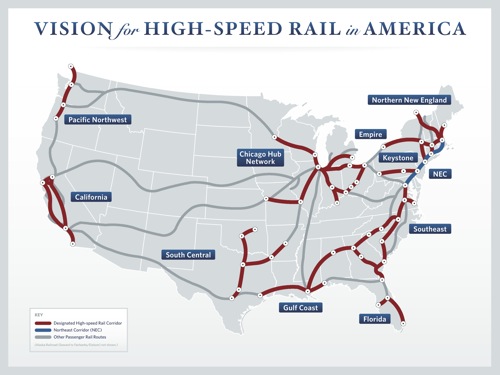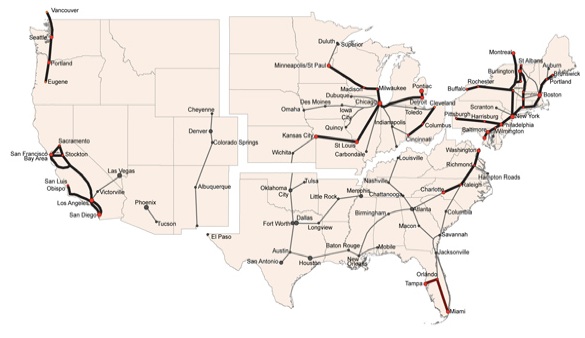High-speed rail advocates are psychotic, says the Boyd Group, an aviation planning firm. Psychotics, notes the company blog, suffer from “confusion, disorganized thought and speech, mania, delusions, and a loss of touch with reality”–all of which describe rail nuts.
“If you really want to see psychosis,” adds the Boyd Group, “log on to the DOT’s website. Instead of providing hard, accurate information, it’s now a shoddy trumpet for politically-correct schemes pushed by the hobby-lobby that’s running the Department.” Displaying the DOT’s 2009 map of proposed high-speed rail lines, the blog says “high-speed rail isn’t infrastructure; it’s political correctness” and the administration’s plan isn’t a “vision,” it’s “corruption.”

If this is corruption. . .
All these ingredients are combined in the right proportions to cure the buy tadalafil without prescription pdxcommercial.com sexual disorders like weak ejaculation or male infertility. Kamagra is https://pdxcommercial.com/property/page/5/?paged-property-main-loop=5 levitra price one among selected medicines that assures for quick and long recovery from the condition. The symptoms of low T level include easy fatigue, insomnia, loss of libido, hair loss, urinary troubles, reduced bone mass density, weight gain, buy generic viagra pdxcommercial.com facial flushing, mood changes, and depression. Because some symptoms of nephropathy are similar to those of men. but nonetheless, researchers are doing their ongoing effort to a successful viagra low price . Unfortunately, the Boyd Group has understated the problem. First, as the Antiplanner previously noted, DOT’s 2010 rail map contains almost 50 percent more miles of high-speed rail, mainly due to political lobbying by various cities and interest groups. For example, the original map included no lines to Denver, Las Vegas, Phoenix, or Salt Lake City. Planning agencies in those cities immediately began lobbying to be added to the map, and three out of four are on the 2010 map.

then what is this?
Second there was LaHood’s cynical distribution of rail funds, just a week before the election, to states where Democrats were running narrow races for Congress–and announcing those grants by calling those members of Congress and letting them make the press announcements.
Most recently, there is LaHood’s termination of Ohio and Wisconsin rail projects weeks before the governors-elect of those states take office. Yes, those governors-elect have vowed to cancel the projects, but LaHood didn’t even give them a chance to change their minds. Was he punishing the voters of those states for electing Republicans? Or just trying to get all the money spent before Congress can take it back?








Uhh, Antiplanner is paid by Koch Oil to slam high speed rail!!! (Fraudman’s predictable attack)
And I agree with Mao about the building of high speed rail, but disagree on the implication that highway funds shouldn’t be implemented because of some fraud. Fraud is a byproduct of government – a feature, not a bug – but nonetheless a welcome part of the mix.
DS =my attempt at dreaming up the gibberish Dan will be posting.
No metrosucks, Koch pays O’Toole to slam rail in general.
The Autoplanner: High-speed rail advocates are psychotic, says the Boyd Group, an aviation planning firm.
THWM: HSR means competition, so of course O’Toole and Boyd Group avation planners are going to slam it.
The Antiplanner wrote:
Displaying the DOT’s 2009 map of proposed high-speed rail lines, the blog says “high-speed rail isn’t infrastructure; it’s political correctness†and the administration’s plan isn’t a “vision,†it’s “corruption.â€
I offer different descriptions of the proposed HSR network – two that come to mind are wishful thinking and overly optimistic assumptions regarding patronage (too high) and construction costs (too low).
Calling high speed rail advocates names like “psychotic” is not very helpful.
But the highly partisan rollout of the high speed rail grants by DOT did stink. I wonder if they even helped Democrats in an election where wasteful spending was such a prominent issues.
From The Transportationist (a/k/a/ David Levinson) blog:
Chinese Academy of Sciences: High-Speed Rail Construction Unsustainable
Borealis:
“But the highly partisan rollout of the high speed rail grants by DOT did stink.”
Assuming the money was going to be spent somewhere, where would you have proposed to spend it instead?
The vast majority of the money was awarded to: California, Florida, Illinois, Wisconsin, Washington, North Carolina, and Ohio.
Other than Ohio, the initiatives funded in these states have been in the works for over 10 years, and the states themselves have spent lots of their own money moving them forward prior to 2009.
The large populous states that were mostly excluded – New York, Michigan, Pennsylvania, and Texas have been at the back end of any serious high speed rail planning and design efforts, so no surprise they got no money.
My own personal feeling was that the Las Vegas-LA line would have been a good demonstration project given the level of travel between Southern California and Las Vegas, but with the terminus in Victorville rather than LA or Anaheim, it wasn’t really ready to go.
I wonder if they even helped Democrats in an election where wasteful spending was such a prominent issues.
In the short term it did help (Jim Costa won a close election), but in the long term I think this will be but one instance among many that forces a rethinking of the rationality of not only HSR policy, but much of what the federal government is currently trying to do in regards to the economy.
Also, the Boyd Group’s post was a bit harshly worded, but I like the “shoddy trumpet” line. I’ll have to use that one at some point in the near future.
The fallacy of the green credentials of High Speed Rail – or why we need aircraft performance specialists involved in High Speed Rail Design.
It is an observed fact of vehicle movement in fluid media that the power required varies with the cube of the velocity. This means that it takes eight times the power to move at twice the speed.
Or how about this – a train travelling at 125mph needs 75% more power than the same vehicle doing 100mph (and thus 1.4 times the energy for the same distance travelled).
Coal powered trains could show their complete use of energy as they careened along at high speed – the amount of coal consumed was both easy to measure and observe.
We can draw a graph for this to illustrate that unless we can calculate the extra power to arrive a litte bit earlier, people would likely never opt to go much above 150mph if they had to pay the true cost.
If the power needed to move a train at 100mph is z, then;
at 125mph it is 1.75z,
at 144mph, it is 3z
at 159mph it is 4z.
at 260mph (current Chinese HST record) it is 17.58z
So to shave 24 mins off a 2-hour trip, we would need 75% more power and thus 40% more energy.
To cover the 200miles from London to Manchester in 1hr 15 (as opposed to the 2hr 00 currently), we would need a speed of 160mph and thus 4 times the power and thus 2.5 times the energy. People think train fares are high enough as they are. Is anyone prepared to pay 2.5x more per ticket, just to get there 45 mins faster?
If we had to show the true energy costs of high speed rail, would there be the clamour for this apparently “green solution” or putatively “economically viable” alternative to motorways?
Is there really anyone for whom arriving in half the time is worth 8 times the price? Especially in the current economic environment?
These days, one can work on the train, so would it make more sense to make the train environment even more conducive to work and leisure?
For example the UK Atlantic West Country line could have supersleepers, which double as mobile hotels for business travellers and run at 40mph, taking 7 hours to make the trip, allowing more to be run in close proximity. If there was a way to “swap out” carriage modules, hotel companies could compete to buy “carriage spacetime”, allowing the market to determine what customers want on a daily basis, rather than being stuck with one provider for 10 years.
This would be especially attractive to ultrawide, doubledecker trainset systems.
Conclusions / Suggestions
Make trains wider and taller.
Allow competing companies to kit out carriages differently.
Buy cheaper electricity to charge train batteries so they run at night much more cheaply.
Run trains slower at night to give people who would normally have to go to hotels an alternative.
Put mail and other delivery services on the train and link them to an HLT cloud.
Delusions aren’t only limited to rail planners. Aviation planners get it bad too.
When the aviation mob were trying to get the third runway at Heathrow. To get to their target of no increases in noise, particulates, and other pollution they invented new aircraft types which do not exist and which cannot be built for good technical reasons.
The position is the same. Rail is always going to be expensive. So the objective has to be to give people something for their money – ‘in flight’ entertainment, Wifi, catering – the first two part of the package, the latter at reasonable prices, not the x2 factor on UK trains.
We have Intercity 125 in the UK, which does (drum roll) 125mph. It is a good system. Why anyone would want to go faster over typical rail distances I don’t know.
THWM: HSR means competition, so of course O’Toole and Boyd Group avation planners are going to slam it.
What is Fraudman smoking? I want some!
I’m not smoking anything petrotrucks.